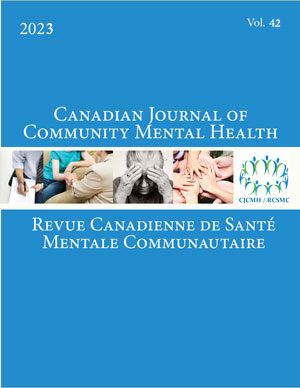Volume 32 • Number 4 • December 2013
Reviewers
Commentary
Articles
OPEN ACCESS
This study examined whether stigma toward mental illness decreased for youth after participating in focus groups in a school-based mental health promotion program called Youth Net (YN FGs). A total of 294 students from 6 high schools participated in a randomized controlled trial, completing questionnaires that measured stigma and depression. Stigma decreased for participants in the intervention group in low-need schools only. Study findings suggest continuing with YN FGs in low-need schools and working collaboratively with community partners to provide evidence of the effectiveness of mental health promotion with youth.
OPEN ACCESS
La violence dans les relations amoureuses (VRA) est associée à d'importantes répercussions sur la santé mentale des jeunes. Considérant le peu d'interventions préventives sur la VRA leur étant destinées, cette étude vise à contraster les perspectives du personnel collégial (n = 57) et des étudiants et étudiantes (n = 278). Les résultats suggèrent des connaissances plutôt justes par rapport à la violence et des attitudes positives face à la prévention. Toutefois, certaines barrières sont identifiées, dont le manque d'outils de prévention et la surcharge de travail. Ces résultats renforcent la nécessité d'offrir des activités de formation et des outils pédagogiques pour soutenir la prévention de la VRA en milieu collégial.
OPEN ACCESS
The United Nations Convention on the Rights of Persons with Disabilities (CRPD) is often recognized as emphasizing a “universalist” approach to difference that discourages the identification and segregation of particular groups based on their characteristics. This emphasis raises questions about Canada's Mental Health Courts (MHCs) and court-diversion programs that identify and respond to people with mental disabilities as a group and can be seen to reflect a “minority rights” approach to the accommodation of difference. These questions need to be addressed to ensure that Canada complies with its international obligations under the CRPD.
OPEN ACCESS
Cette étude s'intéresse à la place des approches médicales et de la médication psychotrope dans les services et interventions offerts aux jeunes en difficulté hébergés dans des ressources communautaires autonomes (Auberges du coeur) de Québec et de Chaudière-Appalaches (Québec). Notre devis s'appuyait sur des méthodes qualitatives: 33 entrevues individuelles et 4 groupes de discussion; analyse thématique des contenus. Nos résultats font ressortir que: (a) l'implication médicale se produit sur les plans interactionnel, conceptuel et institutionnel; (b) comme les processus de médicalisation, les médicaments eux-mêmes doivent être considérés dans leurs dimensions extra-thérapeutiques. En ce sens, les médications psychotropes prescrites aux jeunes fréquentant des Auberges du coeur sont plus que des molécules dont l'usage répond à une rationalité strictement médicale: il s'agit de « phénomènes sociaux » impliquant divers acteurs (individus, groupes et organisations) ainsi que des institutions. Dans ce contexte, devrait-on parler de la « socialisation du médical » autant que de la « médicalisation du social »?
Brief report
OPEN ACCESS
This study examined the relationship between family communication, school engagement, negative peer behaviours, and depressive symptoms in a sample of youths experiencing homelessness. Interviews were conducted with 123 youths experiencing homelessness. Outcome measures included youth self-reports of negative peer behaviours, family communication levels, school engagement, and depressive symptoms. After controlling for demographic variables, higher family communication (b = -0.38, t = -2.74, p = 0.007) and higher school engagement (b = -4.32, t = -2.61, p = 0.01) were significantly associated with lower levels of depressive symptoms. Negative peer behaviours were not associated with depressive symptoms in the sample. Family communication and school engagement may serve as protective factors against depressive symptoms in youths experiencing homelessness. Practitioners who work with youths experiencing homelessness may collaborate with the youths, schools, and families to improve school engagement and family communication when possible.
Student contest winner
OPEN ACCESS
The prevalence of childhood obesity in Canada continues to rise. While the relationship between chronic conditions and related physiological co-morbidities has been examined extensively, less attention has been focused on the psychological and social implications of increased adiposity. This paper addresses the impact of social stigmatization and discrimination, specifically bullying, on the psychological well-being of obese children, and highlights potential solutions from a population health perspective. Additional attention is required to study the impact of stigmatizing experiences on the emotional well-being of obese children and adverse psychosocial outcomes that may be exacerbated by weight bias.










